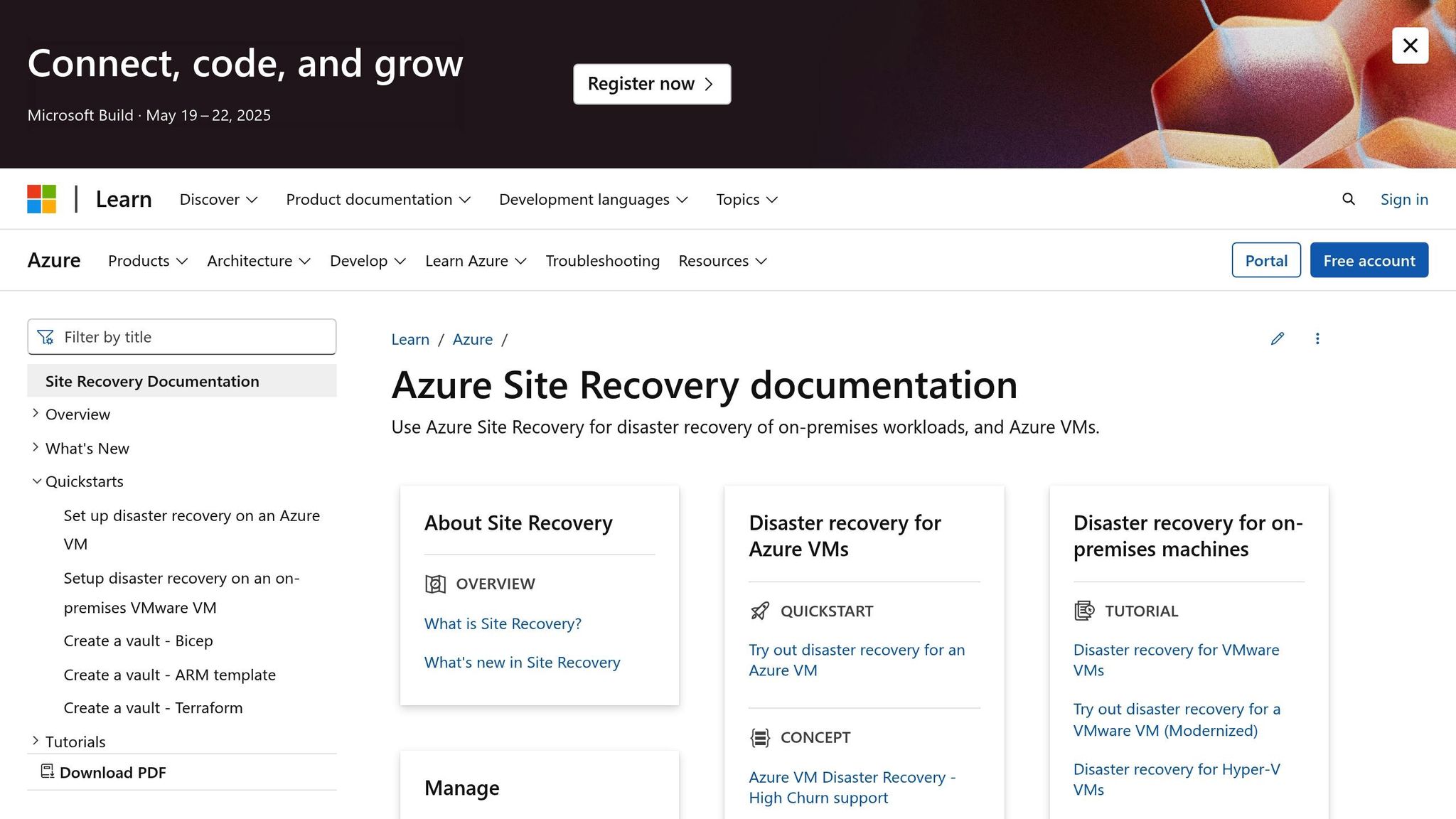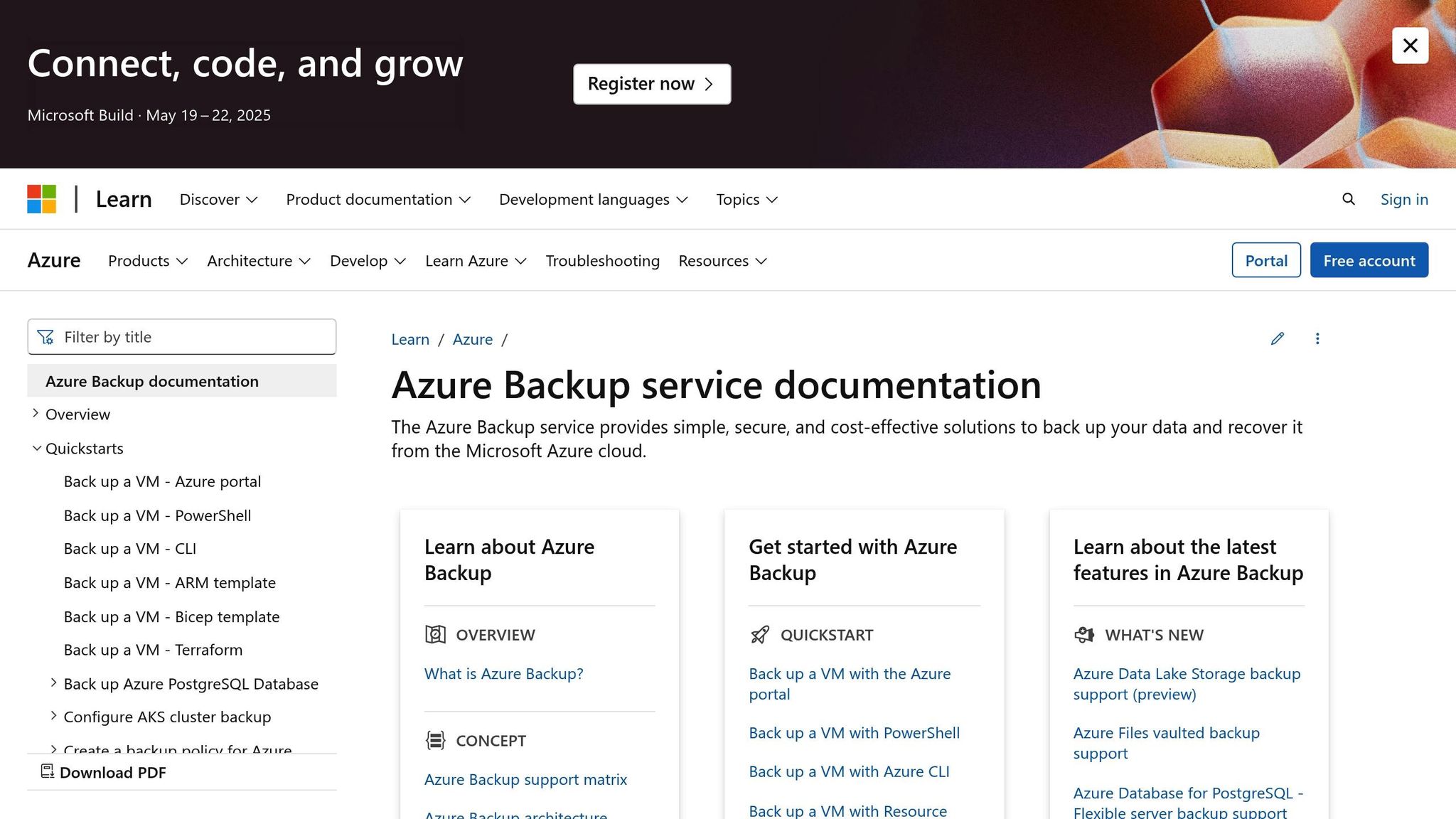RPO Best Practices for Azure Disaster Recovery
Learn essential best practices for setting and managing Recovery Point Objectives (RPO) in Azure disaster recovery plans.

Recovery Point Objective (RPO) is all about how much data your business can afford to lose in a disaster. If you're using Microsoft Azure, here's what you need to know:
- What is RPO? It sets the time limit for acceptable data loss. For example, an RPO of 1 hour means you must restore data from no more than an hour before the disaster.
- Why it matters: Shorter RPOs reduce data loss but cost more (e.g., frequent backups, higher storage needs). Longer RPOs are cheaper but risk more data loss.
- Azure tools for RPO: Services like Azure Site Recovery and Azure Backup help meet RPO goals. Use storage replication options (like Geo-Redundant Storage) for added protection.
- Testing is key: Regularly test your disaster recovery plan to ensure it works effectively and aligns with your RPO targets.
Quick Overview: Azure RPO Strategies
- Critical systems (e.g., payments): RPO < 15 minutes
- Important systems (e.g., internal tools): RPO 1–4 hours
- Non-critical systems (e.g., archives): RPO 24+ hours
Balancing cost and protection is vital. Use Azure Cost Management and Azure Monitor to track expenses and performance. Regularly review and update your RPO strategy to adapt to your business needs.
Azure Disaster Recovery 101: RPO, RTO, and the Basics
Setting RPO Requirements
Defining RPO (Recovery Point Objective) requirements involves evaluating your business priorities and technical capabilities.
Priority Systems and Data
A tiered approach helps prioritise systems based on their importance:
Tier 1 – Mission Critical
- Financial transaction systems
- Customer-facing applications
- Core business databases
Suggested RPO: 15 minutes or less
Tier 2 – Business Critical
- Internal communication systems
- Document management systems
- Business analytics
Suggested RPO: 1–4 hours
Tier 3 – Non-Critical
- Development environments
- Testing systems
- Archive data
Suggested RPO: 24 hours or more
Cost and Compliance Factors
Financial Considerations:
Frequent backups can drive up costs for storage, bandwidth, licensing (e.g., Azure Site Recovery), and backup management. Balancing these expenses with your recovery needs is key.
Compliance Requirements:
- GDPR data protection rules
- Industry-specific regulations
- Regional data residency requirements
- Audit trail and record-keeping mandates
Costs will vary based on data volume and the Azure services you choose. For more guidance on managing Azure costs, check out Azure Optimisation Tips, Costs & Best Practices.
RPO Trade-offs
Advantages of Shorter RPOs:
- Reduces data loss during recovery
- Speeds up system restoration
- Supports compliance efforts
- Boosts service reliability
Challenges of Shorter RPOs:
- Demands more storage and network resources
- Increases complexity in management and infrastructure
- Raises operational costs
For high-transaction systems, shorter RPOs are often necessary despite the added costs. Less critical systems can afford longer RPOs.
Set realistic RPO targets that balance protection and cost. Regularly review these goals to ensure they align with your evolving business needs and disaster recovery strategy.
Azure RPO Tools and Services
Azure provides a range of tools designed to handle disaster recovery. At the forefront is Azure Site Recovery (ASR), which simplifies replication and oversees snapshots.
Using Azure Site Recovery

With Azure Site Recovery, you can automate the replication of critical systems and manage snapshots that are consistent with your applications. To enhance this, Azure Backup adds an extra layer of protection by supporting various workloads.
Azure Backup Methods

After setting up automated replication, Azure Backup offers adaptable options for data protection. It supports both agent-based and agentless backups, catering to different needs. For instance, frequent transaction log backups can help meet stricter RPO targets, while less critical data might only require occasional backups.
Storage Replication Options
Azure's storage replication solutions provide varying levels of data protection:
- Locally Redundant Storage (LRS): A cost-effective option for single-region protection.
- Geo-Redundant Storage (GRS): Ensures cross-region redundancy for high-priority data.
Choosing the right replication method is key to aligning with your RPO goals. To maintain effectiveness, it's important to regularly monitor the health of your replication setup and test recovery processes systematically.
RPO Setup and Testing
Set up and test your Azure RPO strategy on a regular basis to ensure it remains effective.
Data Replication Methods
Azure provides both synchronous and asynchronous replication options, along with a near-synchronous method. Here's how they compare:
| Replication Type | RPO | Bandwidth | Cost |
|---|---|---|---|
| Synchronous | No delay | 10+ Gbps | £££ |
| Asynchronous | 5–15 minutes | 1+ Gbps | ££ |
| Near-synchronous | 30–60 seconds | 5+ Gbps | £££ |
Once your replication method is chosen, it's crucial to test your recovery plan thoroughly.
Recovery Plan Testing
Regular testing is essential to ensure your recovery plan works as expected. Use an isolated environment that closely mirrors your production setup. Focus on these key areas during monthly tests:
- Data consistency: Ensure no data is lost or corrupted.
- Application functionality: Verify that applications operate as intended post-failover.
- Inter-site latency: Measure the time it takes for data to travel between sites.
- Recovery times: Confirm recovery times meet your defined objectives.
Analysing these results helps fine-tune your RPO settings and improve overall system performance.
RPO Tracking and Updates
Azure Monitor is an excellent tool for keeping track of replication health. It provides key metrics such as:
- Replication lag time: Shows how far behind the replication is.
- Recovery point age: Indicates the age of the most recent recovery point.
Set up alerts in Azure Monitor for scenarios like:
- RPO exceeding 15 minutes
- Failed replication attempts
- Storage nearing capacity
- Network connectivity issues
Review and update your RPO strategy every quarter. Consider factors like test results, performance data, changing business needs, cost-saving opportunities, and compliance updates. This ensures your strategy stays aligned with evolving requirements.
RPO Cost Management
After setting up and testing your RPO effectively, managing costs becomes a key focus. The goal is to strike a balance between your recovery needs and budget. For SMBs using Microsoft Azure, aligning cost-saving strategies with business requirements is essential.
System Priority Levels
Group your systems into tiers based on their recovery needs and the financial impact of downtime:
| Priority Level | RPO Window | System Types | Example Cost Impact |
|---|---|---|---|
| Critical | Less than 15 mins | Payment processing, customer data | High |
| Important | 1–4 hours | Internal applications, reporting tools | Moderate |
| Standard | 4–24 hours | Development environments, archives | Low |
These tiers should reflect factors like revenue impact, compliance requirements, customer expectations, and operational dependencies.
RPO Cost Factors
Several elements directly influence the cost of maintaining RPO on Azure:
Storage Costs
- Premium storage for critical systems is more expensive than standard storage.
- Snapshot storage is typically cheaper than active storage.
- Always refer to the latest Azure pricing for specifics.
Network Usage
- Transferring data between Azure regions adds to costs.
- Bandwidth usage also affects replication expenses.
Compute Resources
- Costs include running test environments, failover instances, and automation for recovery processes.
Budget Planning Tools
Azure provides tools to help you manage RPO-related expenses effectively:
Azure Cost Management
This tool enables you to monitor your disaster recovery costs in detail. Use it to set alerts for unusual replication traffic, storage limits, or monthly budget thresholds.
Azure Advisor
Get tailored recommendations for optimising recovery resources. It can help you adjust storage tiers, right-size infrastructure, and identify underused failover setups.
For more detailed guidance, check out Azure Optimization Tips, Costs & Best Practices. These tools integrate well with Azure's broader cost management features, making it easier to keep your disaster recovery spending under control.
Summary
This section simplifies the key points about creating an effective RPO strategy using Azure. By aligning business priorities with technical capabilities, you can build a solid disaster recovery plan that focuses on preparation and ongoing maintenance. Here's a quick breakdown of the essentials:
- Focus on critical systems: Prioritise systems based on their impact on your business.
- Choose efficient replication methods: Keep costs under control while ensuring data protection.
- Regularly test recovery plans: Make sure your disaster recovery processes work as expected.
To keep things running smoothly:
- Reassess system priorities to match current business goals.
- Keep an eye on storage costs and adjust as needed.
- Frequently test your recovery steps to ensure reliability.
Take advantage of Azure's cost management tools to monitor expenses and adjust resources in real time. For more tips on managing Azure costs and optimising your cloud setup, check out Azure Optimization Tips, Costs & Best Practices.
FAQs
How can I set the right RPO for different systems in my organisation using Azure?
To determine the appropriate Recovery Point Objective (RPO) for your systems in Azure, start by assessing the criticality of each system and the potential impact of data loss. Identify systems that require near-zero data loss, such as financial or operational databases, and those where longer RPOs are acceptable, like archival systems.
Azure offers tools like Azure Site Recovery and Backup, which allow you to customise RPO settings based on your organisation's needs. Regularly test and review these configurations to ensure they align with your disaster recovery strategy and business continuity goals. For small and medium-sized businesses (SMBs), balancing cost-efficiency with performance is crucial. You can explore additional tips on optimising Azure for SMBs to manage costs and improve performance effectively.
Remember, setting the right RPO is not a one-size-fits-all approach. It requires continuous evaluation as your business evolves and new systems are introduced.
What are the cost implications of using a shorter RPO in Azure, and how can I optimise these costs effectively?
Implementing a shorter Recovery Point Objective (RPO) in Azure can increase costs, as it often requires more frequent data replication and additional storage resources. These costs can vary depending on the size of your data, the replication frequency, and the Azure services used.
To manage these expenses effectively, consider the following:
- Optimise data replication: Use incremental backups or differential snapshots to minimise data transfer and storage costs.
- Leverage Azure cost management tools: Monitor and analyse your spending to identify areas for optimisation.
- Right-size your resources: Ensure you're only using the storage and compute resources necessary for your disaster recovery needs.
By carefully balancing your business continuity requirements with cost optimisation strategies, you can achieve an effective disaster recovery plan without overspending.
How can I ensure my Azure disaster recovery plan meets industry regulations and data protection laws?
To ensure your Azure disaster recovery plan complies with industry regulations and data protection laws, start by identifying the specific requirements relevant to your sector and location, such as GDPR in the UK. Use Azure services like Azure Policy to enforce compliance standards and monitor for potential violations.
Additionally, regularly review and update your recovery objectives (RPO and RTO) to align with regulatory guidelines. Conduct routine audits and testing of your disaster recovery setup to verify that it meets both performance and compliance standards. For further insights on optimising your Azure environment, consider exploring expert tips on cost, security, and performance tailored for SMBs.




